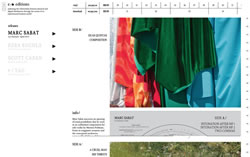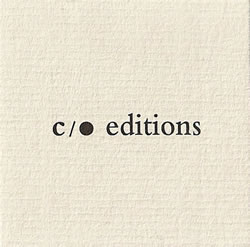Negative Money
Care Of Editions
I
Care Of Editions is a record label that gives people money for downloading the music we release. To keep from going into debt, the downloads are released in limited editions. It’s not the limitation of downloads or the loss of money that motivates the project, but an interest in finding a trace of difference where none exists. Numbers can index a difference that already separates limited objects, but downloads are virtually identical and virtually unlimited. There’s no room for difference to be drawn between them. It would have to be faked with an artificial scheme of numbers. For these numbers to make sense, sense would have to be given to them, or they would only be getting in the way. That said, maybe downloads need something opaque to get in the way and to give them a means of contrast. Care Of Editions proposes a framework for limiting downloads that simultaneously exposes itself to consideration: a framework against which people can gauge what significance a single download might have. Unlike downloads, a calculation that’s always in the making could never be the same twice. By inventing a metric that’s barely useful, if at all, downloads might be able to navigate more clearly against the foreign idea of singularity and suddenly have an elsewhere to pursue.
II
Care Of Editions explores the relationship between physical and digital distribution by means of an experimental business model in which the availability of downloads is correlated to vinyl sales. We release every album both on vinyl and as a high-quality download. Customers who download the music will receive money, and this money comes from vinyl sales.

Downloads are made available in real time, whenever there’s enough money to pay the person downloading. So after we sell a certain amount of records, more downloads can be offered. Because the vinyl editions are limited, digital editions would eventually come to an end as well. The project will consist of six releases, to be issued over the course of 2013–15.
Each edition consists of 118 physical records and 45 downloads. At best, we can break even after selling every record. A run of vinyl costs about $1700 USD to press. For each release, we pay a total of $1035 to the people who download. Together that’s $2735, and if we sold all 118 records at $23 per piece, we would recoup almost exactly the same amount: $2714. There are numerous grey areas in the equation, including shipping, fluctuating currencies, overages of production, and promotional copies sold outside the edition, but on the whole it’s meant to balance out.
This balancing-out is visualized on the label’s website through a gesture of disappearance. Its length is determined by the current digital inventory, so it draws to a close as downloads go out of stock. The site is laid out as one long page with a few satellite features, such as the cart and an information page. Each artist section is divided into 45 units; whenever a download is purchased, a unit from that particular artist is subtracted from the site.
Payments increase so that they’re always equal to the download number. With 45 downloads in an edition, the first person would get one dollar and the last person would get 45. Each consecutive download is funded by an increasing amount of vinyl sales, not only because the payments increase, but because of how the profits are apportioned. They’re split between download payments and recouping the production costs, and this proportion is skewed so that more money and more downloads can be made available earlier in the edition and so that we only break even at the very end.

For practical reasons, to prevent anyone who’s receiving a payment from having to then pay additional bank or service fees or become a member of some third-party service in order to receive the money, the payments are sent as a cheque from the Swiss postal bank. This bank works with other banks from all over the world and has them print the cheques in the local currency so that whoever receives a cheque can cash it at the local post office, free of charge.
These cheques would eventually expire if they go uncashed, but it’s possible that their value as an art object could still increase, maybe even beyond their original dollar amount. They would eventually expire if they go uncashed, but it’s possible that their value as an art object could still increase, maybe even beyond their original dollar amount. Either way, the cheques have the possibility of creating, on behalf of the downloads, a performative residue that is ultimately more diverse and more unique than their vinyl counterparts. If the downloads can incentivize accumulation in this way, like the records, this would be a measure of their newfound singularity.
III
The art world is not always as egalitarian as it might wish to appear. Just like the market at large, it places more value on individual creativity and on limited editions than on downloads or any object that’s endlessly reproducible. Moreover, the art market has a somewhat destructive relationship to the immediate past. The distant past can be understood through the lens of nostalgia, but the recent past, the just past, is sometimes difficult to value because it’s neither in the system nor at a distance.
Record labels fall into this category. Now is exactly the wrong time to start one. Nevertheless, an interesting situation is developing as their role in the market becomes less clear. On one hand, there’s a push to forget about them and to deal more directly with endless streams of music, but on the other, a major source of distribution has been lost and this void makes for a curious setting.
IV
Dan Graham has done extensive research into both the just past as well as the immediate contours just outside the upper class. His work with time and delay is well known 1[1. See, for example, Past Future Split Attention (1972), Time Delay Room (1974), or Performance and Stage-Set Utilizing Two-Way Mirror and Video Time Delay (1983).], but also interesting is a point he makes while voicing support for the petite bourgeoisie (Obrist 2012, 106–112). It concerns the similarities between his and Michael Asher’s early work and how they eventually deviated from each other. Asher, known for Institutional Critique, says that the Museum represents the Establishment and that it needs to be deconstructed. He criticized Graham, in particular for his piece on the roof of the Dia Museum in New York, for making what was in his eyes a monument to the Museum, and for going along with the system. Graham constructed a pavilion with curved, semi-reflective, semi-transparent glass in order to open up the function of the museum as well as the role of the viewer. Some elements of the project are certainly a tongue-in-cheek exploration of how the museum elevates “great” artists (Graham 1999, 165–167), but the overall effect is not so clearly a parody of the museum. It supports what the museum does well. It even houses a rooftop coffee bar. This is to say, Michael Asher had a valid point, but Graham’s response is that he’s not against the petits bourgeois. On the contrary, he thinks that they are the revolutionary class. If something is going to give, it’s there, at the point of tension between the upper class and its periphery. So Graham has sought to learn from entertainment and from other forms of leisure typically geared towards an upper middle class public, but at the same time, he’s held onto the periphery. His work is both a parody of the system and something that’s, as he says, “a little bit of a celebration of the petits bourgeois” (Obrist 2012).
This is the balance that Care Of Editions is trying to elicit by being half-rooted in the market. There’s an absurdity, but it can also work, and if it does work, it will in part be thanks to record collectors and other members of the petite bourgeoisie for allowing a collapse between these different logics and different classes to take place.
V
Jean Baudrillard, in regards to this collapse — or gap, as the case may be — writes that:
To analyze present-day systems in their catastrophic reality, to consider not only their failures and aporias but also the way in which they sometimes succeed only too well and get lost in the delusion of their own functioning, is to come face to face at every turn with the theorem or equation of the accursed share. (Baudrillard 1993, 122)
In other words, the failure of the market to treat downloads with the value of a commodity is also a success of their material reality. They are, one could argue, too contemporary to be profitable. They remove the obstacles of location and substance, and so they resemble an economy that has, for its part, also become unpegged from limited materials. When the economy went off the gold standard in 1971 (Graeber 2011, 361), it underwent a transformation and exhibited reversibility for the first time. Until then, it had been the measure of all things finite, and, as such, it only moved by finite steps: one transaction, one resolution or one binding at a time. The idea of endless accumulation was a theoretical horizon. By becoming virtually unrestricted, with free-floating currencies and unending debts, the economy, like downloads, no longer needed to move toward that horizon, since it already started from a point of excess.

Care Of Editions takes a practical stance when it comes to the role of excess. It doesn’t oppose gifting to theft, and it doesn’t pretend that redistribution is the answer to war and plunder. These are all viable ways, depending on the situation, of creating hierarchies, identities and difference (Ibid., 109–113), or even markets (Ibid., 49–50), all of which depend on nothing more than a precedent being set. They don’t appeal to reason, but to a custom. The question, however, is if these are viable strategies when it comes to downloads. Downloads exist in an endless stream, and so they can’t really be given away. They have no significant value as a gift if the recipients already have more free music than they could ever listen to. Downloads are indeed cursed, but it’s not clear whether or not they can be called an accursed share. What is a share, anyway, in terms of the infinite?
According to Baudrillard, “[i]n reversibility, everything is ‘accursed share’ or there is no ‘accursed share’, since there is no residue” (Boyne and Lash 1995, 87).
This is why Care Of Editions is not directly focused on the accursed share. The project takes place at a horizon where excess is not opaque but, instead, transparent, which is to say, already included. It’s not something to be achieved or eliminated, but perhaps given a legible residue. Without converting excess into use, Care Of Editions creates a framework that preserves the possibility of both use and uselessness.
As Baudrillard writes:
Any structure that hunts down, expels or exorcizes its negative elements risks a catastrophe caused by a thoroughgoing backlash, just as any organism that hunts down and eliminates its germs, bacteria, parasites or other biological antagonists risks metastasis and cancer — in other words, it is threatened by a voracious positivity of its own cells, or, in the viral context, by the prospect of being devoured by its own — now unemployed — antibodies. Anything that purges the accursed share in itself signs its own death warrant. (Baudrillard 1993, 106)
VI
Many artistic operations are carried out, often without notice, as an intrusion into the world of business. Artists continually confront the market without needing to try, if only because the market is essentially the automatic paradigm for how the world is rendered. It matters very little what we constitute as art. Letting go of this question, as well as the metrics defining artistic success, can bring us closer to a less automatic question. Instead of questioning art, we can question what it means to be contemporary.
Goodiepal is an artist and a musician who dissolves the parameters of art into a series of business transactions that are emblematic of the structure and operations of contemporary life. In 2010, he put out a record that came with a bill for 500 Danish kroner, which was worth about six or seven times more than the record cost. He later put out a series of three LPs, priced 2.60 Euro, 11 Euro and 100 Euro, respectively. The cheapest one came with Goodiepal’s banking information, so it gave unlimited access to his account for both withdrawals and deposits. The second record came with a one thousand-roma bill, supposedly exchangeable if the Romani people were to ever establish a homeland. The most expensive LP came with a signed blank cheque, allowing the purchaser to make one withdrawal from Goodiepal’s account (Peanut Snake 2011).

Goodiepal is dealing directly and provocatively with selling music at a loss without connecting or exchanging the aims of business and art. By tying a currency to the possibility of the Romani establishing a homeland, he’s expressing contentment with the nature of his project being nomadic. It can’t force success, whether that’s measured in terms of business or art. The Romani are more of a symbolic group that sums up his project’s lack of forcefulness. It speaks to a much more general set of people, or set of parameters, which could be found just about anywhere, without reason, since the criteria for success is made indiscernible, and at the same time, an alluring part of the project.
Goodiepal is basically burying the means of evaluating his work. He created a calculation whose usefulness subtracts itself from the rest of the world. Even though it has an impersonal, economic footprint, it’s also clearly tied to human relations. This touches on a number of important details. First of all, his project, like Care Of Editions, is indebted to many other artists. The classic examples of an ephemeral calculation (which are beyond the scope of this paper) would be: Stéphane Mallarmé, who more or less hinged his calculation on a single, disappearing point (i.e. a poem, or a roll of the dice, providing its own means of seeing a “unique Number that cannot be another” [Meillassoux 2012]); and Chris Marker, who dispersed the calculation throughout his entire body of work (i.e. the coming together of poetry and history where facts are reconsidered in terms of appearances, and where Marker’s entire persona is made visible only as it vanishes into a network of filmic signatures, inscribing him and his questions into a fleeting history unlike any other). Yet at some level, this happens all the time. Every artist, whether she’s conscious of it or not, places herself in a lineage. It’s an artificial timeline that’s excluded from the rest of history: a tangent that helps an artist evaluate her work and perhaps only her work. This interplay of history and the personal is an echo of the dialogue between business and art. Like money, it’s a form of measuring indebtedness. Goodiepal, however, infuses the cash market with a form of social capital. He gives this currency a performative value that can only meander unpredictably before being cashed in, if ever, as well as a legibility that relies mostly on thought.
VII
A number of anthropologists have suggested that every time coins first emerged, in different parts of the world, it sparked an in-depth consideration of the relationship between the material world and its other. David Graeber writes:
It would be foolish to argue that all Axial Age philosophy was simply a meditation on the nature of coinage, but I think Seaford is right to argue that this is a critical starting place: one of the reasons that the pre-Socratic philosophers began to frame their questions in the peculiar way they did, asking (for instance): What are Ideas? Are they merely collective conventions? Do they exist, as Plato insisted, in some divine domain beyond material existence? Or do they exist in our minds? Or do our minds themselves ultimately partake of that divine immaterial domain? And if they do, what does this say about our relation to our bodies? (Graeber 2011, 245–247)
We could say that the concept of money is given use and legibility through coinage. Whenever markets have gone into a cycle of credit, or now that the economy is no longer tied to a material, coinage better resembles the concept of money. The role of semblance doesn’t interfere with this happening, even if semblance and artifice are so often considered suspicious elements (Badiou 2005, 1–15): poets and mimesis, for example, being banned like accursed shares from Plato’s rendering of the perfect city in The Republic. Coinage and other objects can take on the qualities of a concept even from within the market. The record label Ghostly International, for example, no longer depends on producing records. Their product is an image or an idea of who they are, and they’ve been so successful at cultivating this brand, they could stop selling music altogether and focus solely on designer merchandise. For better or worse, it barely matters what music they release, and there’s something conceptual about that, even if it comes from marketing. 2[2. Of Art and Artifice is a phrase associated with the Ghostly International brand.]
VIII
Care Of Editions tries to visualize the movement from objects to concepts. The two most basic examples of this are the debt, which comes from the cost of production, and the website. The debt is resolved according to vinyl sales, and the website compresses in proportion to downloading so that both would potentially disappear if the project were to come to a close. What it would leave behind is a residue that could take many forms, from records, downloads and cheques, to transactions, experiences and perceptions, any of which could contribute to the perception of objects beyond this project. In that sense, the residue marks a movement in the other direction, from an idea to an object, or to another idea. The pivot between the two is the participation of the audience, and two of the most direct points of contact with the audience are the music and the branding.

The most visible aspect of our branding is the chart that depicts the business model (Fig. 2). It is on the back cover of every record released by Care Of Editions, and it helps clear up the logic of the site as well. This element of the branding is a stripped-down rendering of how the project works. The logo design, business cards and typography, as well as the photography for the front covers and the website, all take a more intuitive approach that is drawn from a careful study of marketing and label identity (Figs. 3–5). The overall project, including the business model and the branding, could ultimately be used as an envelope to release almost any music. The coherence of our releases could be chaotic or even randomly consistent. Perhaps that says something about the place of labels today. It’s not that Care Of Editions is critical of the envelope-like function of labels, but we focus on this aspect because it marks the last visible point along an outer periphery of what a label could be. It’s a perch where we can position ourselves and see what happens.
The curatorial arc is actually the most difficult element of the project to formulate. Even though I’d like to rest the project on something nomadic, via the music, it’s impossible to know whether or not it is. I do feel, because of the experimental nature of the economic model, avoiding signs of experimentation in the music would, in a sense, blow the cover of æsthetic coherence. In other words, the æsthetic coherence lends support to the economic coherence. Paying people is a moment of theatre that allows the business model to operate under the cover of an economic reason. Even though giving money away goes against common economic sense, it sets up the sensible practice of restricting free money as well as downloads to what we can afford. This is riding on the fact that, today, economic reasons tend to set the bar for clarity, as they often go unquestioned. With the music, there is no æsthetic starting point unless it’s borrowed from the economic framework. If the records were only experimental, the business model would seem like a gimmick to help sell records that wouldn’t sell on their own. On the other hand, if we only released music that already had an established place in the market, then the project would be a critical interruption of the market. Instead, the æsthetic coherence comes from a collaborative starting point, set together with the musicians and without being so tied-up in sincerity, which is to say, the spirit of capitalism or the critique of capitalism (Boltanski 2008, 53–71).
IX

Care Of Editions borrows strategies from the market in order to lend richness to a virtual space that seems otherwise flat. It enlists these tools in the service of an imaginary economy where values of both a positive and negative intensity can be held together. Unlike more critical projects, it doesn’t condemn the market for being artificially structured or for projecting its own brand of perspectival space out beyond its borders. Being too concerned with artifice or excess, we can automatically overlook the fact that this perspective, artificial or not, gives manœuvrability to a concept. It allows material traces, such as coins, to operate within it. These traces are coextensive with a concept. Whatever the concept’s finite consistency, it’s a subset of its infinite multiplicity. It’s where the idea comes to perform. Ignoring that doesn’t bring us any closer to it. It’s a censorship that would only protect an idea from our considerations. So the issue’s not with artifice. Concepts find a way to perform, one way or another. What Care Of Editions proposes, then, is a consideration of the impossible that might not censor every measure of its impossibility.
Bibliography
Badiou, Alain. Handbook of Inæsthetics. Trans. Alberto Toscano. Stanford CA: Stanford University Press, 2005.
Baudrillard, Jean. Transparency of Evil: Essays on Extreme Phenomena. Trans. James Benedict. London: Verso, 1993.
Boltanski, Luc. "The Present Left and the Longing for Revolution." In Under Pressure: Pictures, Subjects, and the New Spirit of Capitalism. Edited by Daniel Birnbaum and Isabelle Graw. Berlin: Sternberg Press, 2008, pp. 53–71.
Boyne, Roy and Scott Lash. “Symbolic Exchange: Taking Theory Seriously. An Interview with Jean Baudrillard.” Theory, Culture & Society 12/4 (November 1995), pp. 79–95.
Graeber, David. Debt: The First 5,000 Years. Melville House Publishing: Brooklyn NY: 2011.
Graham, Dan. Two-Way Mirror Power: Selected Writings by Dan Graham on His Art. Edited by Alexander Alberro. Cambridge MA: MIT Press, 1999.
Meillassoux, Quentin. The Number and the Siren: A Decipherment of Mallarmé’s Coup de dès. Trans. Robin Mackay. Paris: Urbanomic / Sequence Press 2012.
Obrist, Hans Ulrich. Dan Graham. The Conversation Series 25. Cologne: Walther König, 2012.
Peanut Snake. “Time Does Not Exist.” 27 March 2011. Available online at http://peanutsnake.blogspot.de/2011/03/time-does-not-exist.html [Last accessed 1 October 2012]
Social top